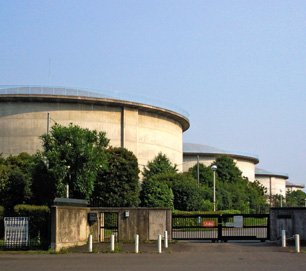Alum (Aluminum Sulfate)
| EPA Maximum Contaminant Level Goal (MCLG) |
Aluminum | 0.05 to 0.2 mg/L |

A water purification plant in Tokorozawa, Japan.
One of the first of the several steps that municipal water suppliers use to prepare water for distribution is getting it as clear and as particulate-free as possible. To accomplish this, the water is treated with aluminum sulfate, commonly called alum, which serves as a flocculant. Raw water often holds tiny suspended particles that are very difficult for a filter to catch. Alum causes them to clump together so that they can settle out of the water or be easily trapped by a filter.
Usually a mixture of water with 48 percent filter alum is injected into the raw incoming water at a rate of 18 to 24 parts per million. The alum promotes coagulation of fine particles which helps resolve problems of color as well as turbidity. If the process is given enough time to work and is applied properly, it not only corrects problems in the water but actually results in removing most of the aluminum used in the process.
Health Effects of Alum/Aluminum
Although concern over the safety of treating water with aluminum has often been voiced, there is no evidence that aluminum in water, whether it comes from the aluminum sulfate used in treatment or from other sources, is a health issue. Actually, most aluminum that we take in does come from other sources. One study showed that only between 0.4% and 1.0% of our lifetime intake of aluminum comes from alum used to prepare municipal water. Most aluminum intake is from aluminum that occurs naturally in foods, aluminum used in food packaging, and from products like deodorants and vaccines.
Water Treatment for Alum/Aluminum
Water treatment for aluminum is normally not needed, but aluminum is easy to remove with reverse osmosis or distillation.
Photo source: WikiMedia, author: tokoro koko
Site Index
Filtration Systems
- Aeration for Iron & Sulfide
- Backwashing Filters
(whole house & well units)
- Chlorine & Chemical Injectors
- Countertop Water Filters
- Garden Hose Filters
- Reverse Osmosis, Residential
- Reverse Osmosis, Commercial
- Shower Filters
- Specialty Filters
- Ultraviolet Systems
- Undersink Filters
- Water Softeners
- Whole House Filters
Cartridges
Parts
- Replacement Parts
- Faucets
- Filter Media
- Fittings
- Housings
- O-rings
- Pumps
- Pura UV
- R.O. Parts
- R.O. Tanks
- R.O. Booster Pump
- VIQUA UV